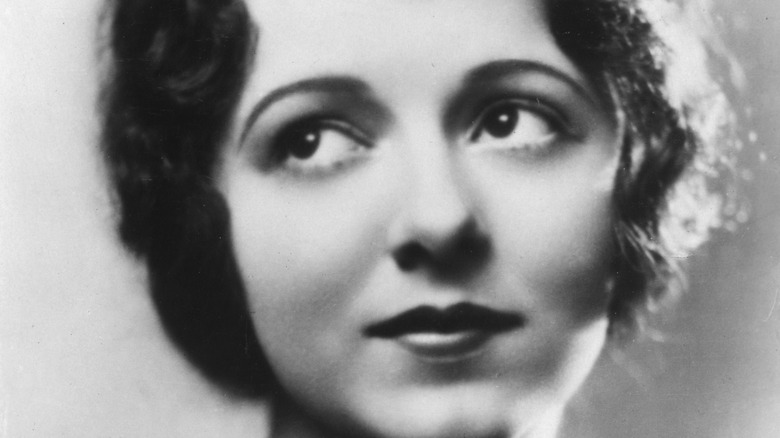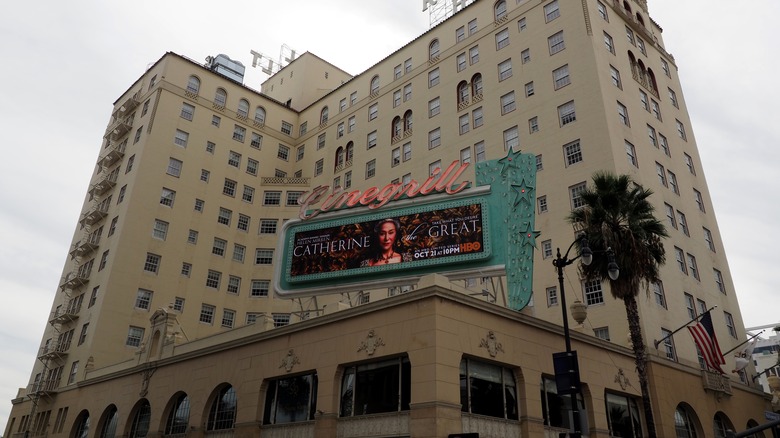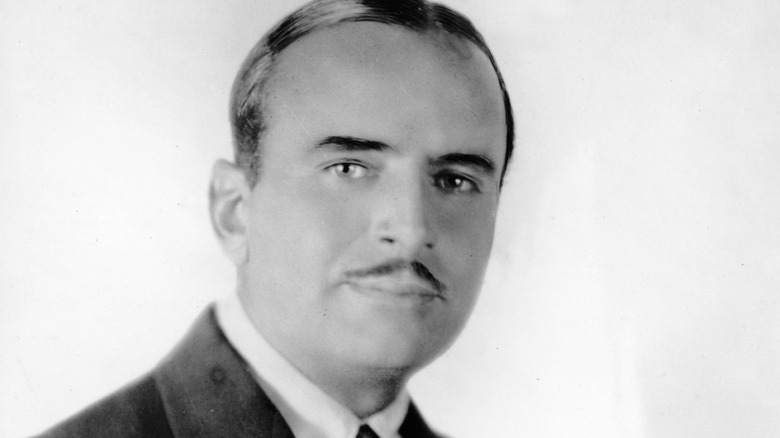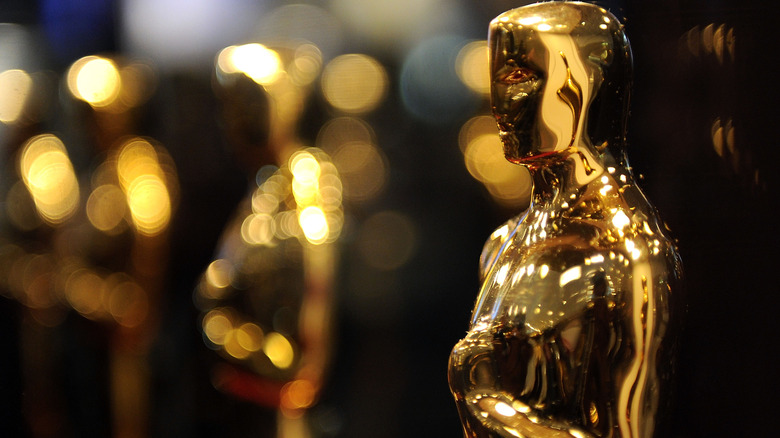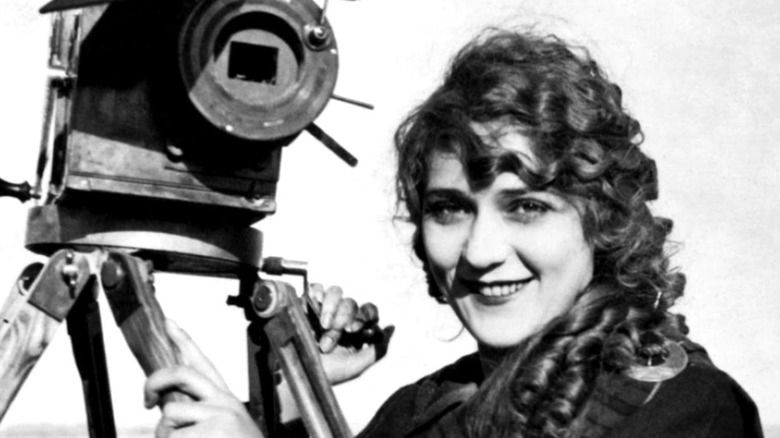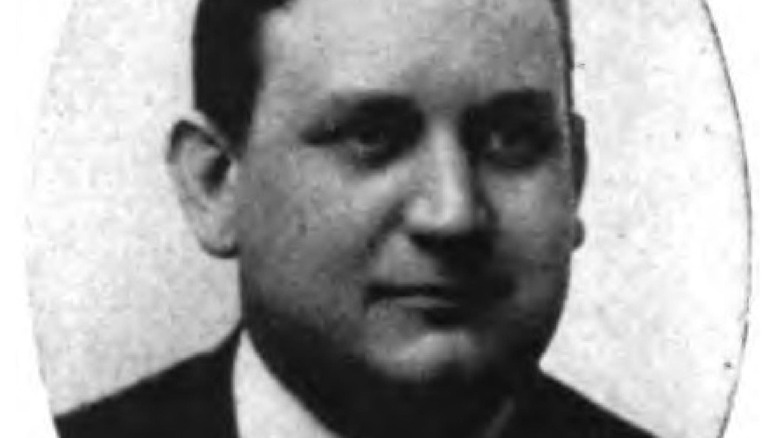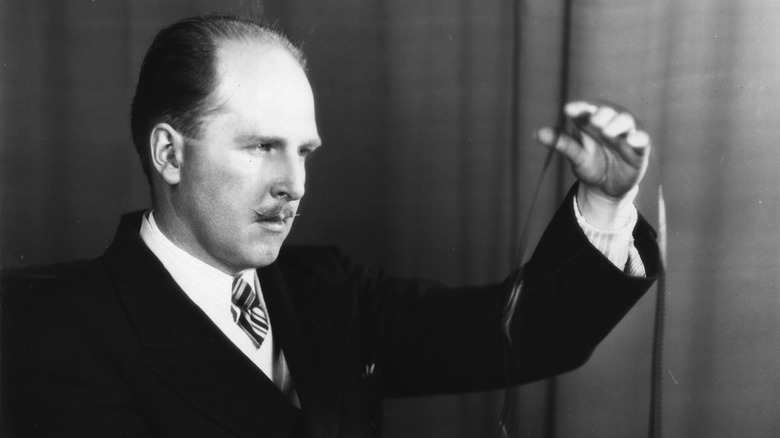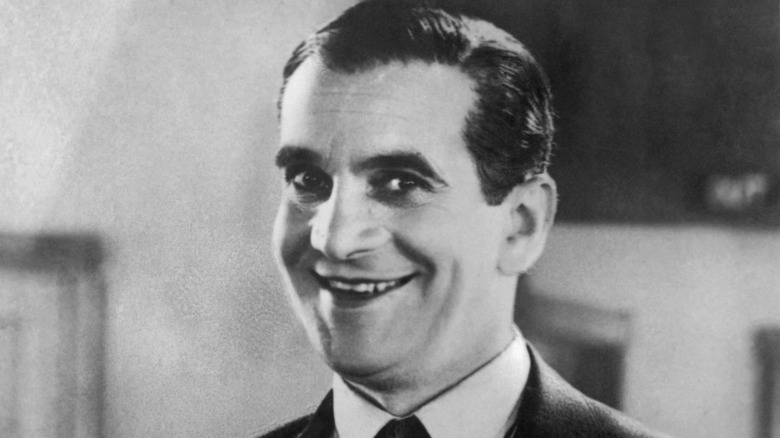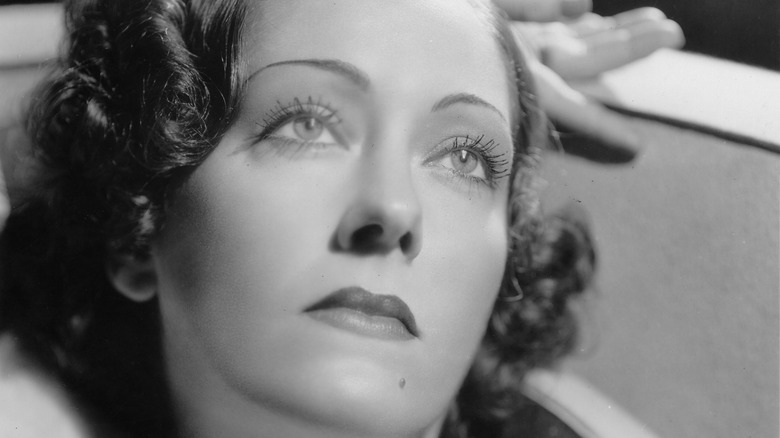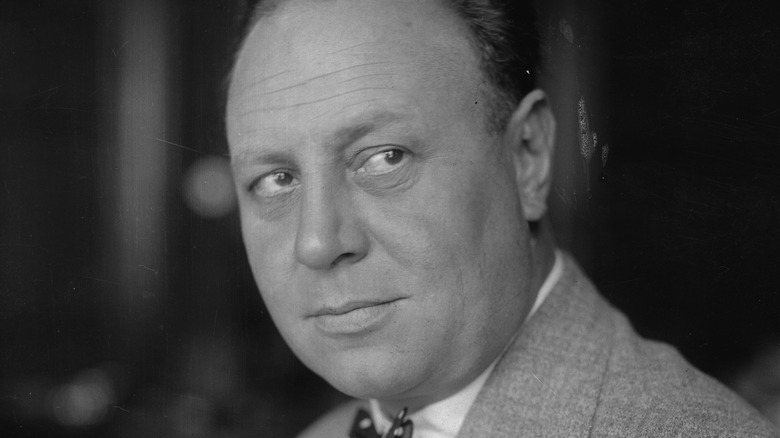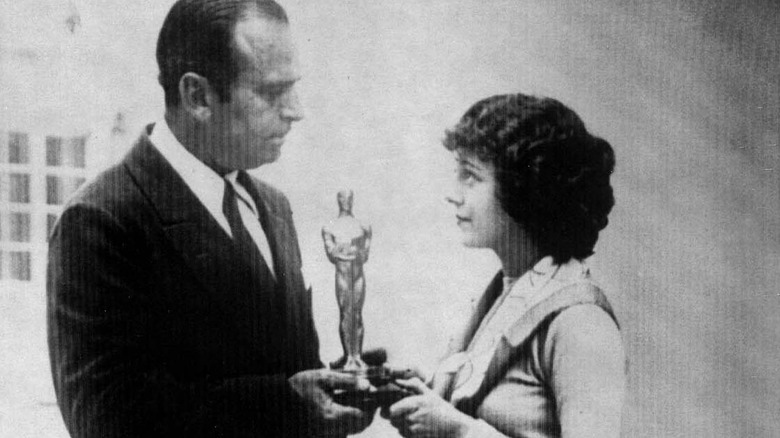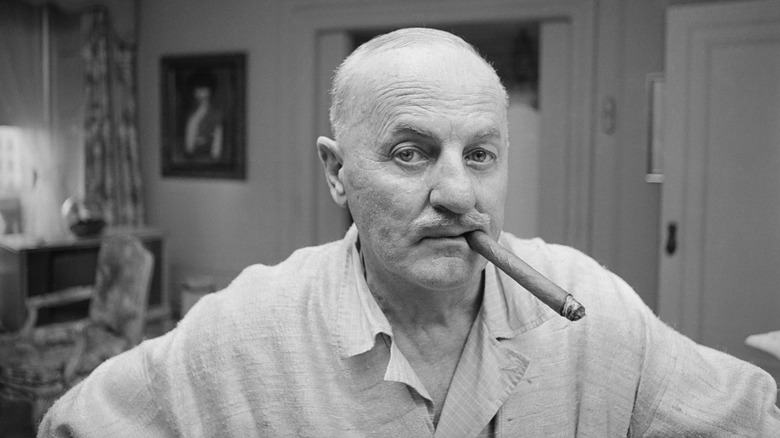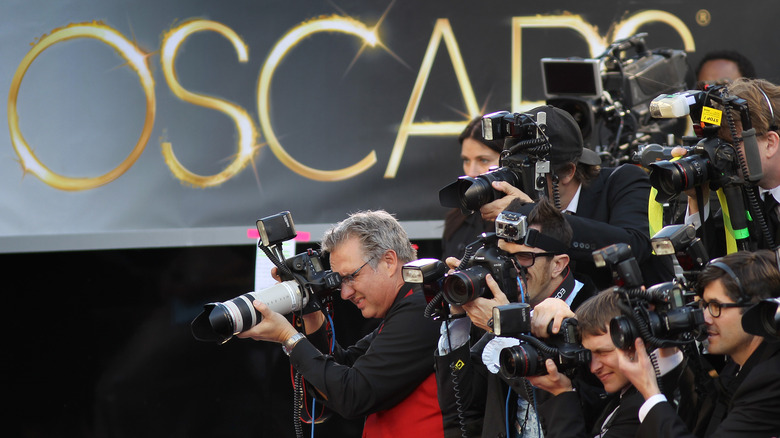A Look At The First Academy Awards Ceremony
The Academy Awards — aka The Oscars — is a big part of pop culture. There's the breathless build-up to the ceremony, the announcement of (and associated controversies surrounding) the nominees, the fashion and glamour of the red carpet arrivals, and then the ceremony itself.
The ceremony is always a little extra. Sometimes more than three-and-a-half hours long (per the Los Angeles Times), the sheer length and sloppiness of the Oscars has itself become a bit of a running joke, and the self-indulgence of rambling acceptance speeches, awkward comedy skits, and occasional acts of shocking violence making the whole ceremony into quite the spectacle. After all, it's been more than 90 years since the first Academy Awards were presented in 1929 — that's a lot of legends to live up to.
But it wasn't always like this. According to Entertainment Weekly, the Oscars weren't even broadcast on radio until 1930, and The Hollywood Reporter notes the ceremony wasn't televised until 1953. Simply because it was a more private event, the Academy Awards were a lot less complicated and glamorous in the early days. In fact, the very first Oscars ceremony was a very, very different affair than today's lavish productions, in part because no one at the time could have imagined how popular they would become. Here's a look at the first Academy Awards ceremony.
It was super small
Everything about the modern-day Oscars is pretty big. According to Vogue, as of January 2023, Oscar planners were scheduling that year's ceremony to be held at the Ovation Hollywood Theater (formerly the Dolby Theater) at the beginning of the year. NBC News reports this theater can seat up to 3,317 people. And even in 2022 when the ceremony was kept smaller due to pandemic restrictions, about 2,500 people showed up for it. Most ceremonies breeze past the three-hour mark, according to the Los Angeles Times — and that doesn't count the red carpet portion of the evening.
But the first Academy Awards ceremony was very, very different. According to History, it was held in the Blossom Room at the Hollywood Roosevelt Hotel, making it not much different than any other reception or party. There was dancing and a dinner of broiled chicken, string beans, and potatoes. Just 270 people attended, some of whom had actually paid $5 for a ticket to the event. And most strikingly, according to The New York Times the entire ceremony lasted just 15 very short minutes — partially because, as The Washington Post reports, the winners had been announced three months earlier, removing any sense of tension from the evening.
In fact, the awards given out and the show itself weren't even known as the Oscars yet. The iconic gold statuette (designed by Cedric Gibbons and created by sculptor George Stanley) wasn't called an Oscar until 1931.
Douglas Fairbanks Sr. was the host
One thing that hasn't changed since the first Academy Awards in 1929 is that the show (almost) always has a host. The ceremony has experimented with going "hostless." CBS News reports that in 2019 Kevin Hart pulled out of the hosting job after backlash over his social media posts, and in 2020 and 2021 the Oscars went without a host entirely, something that also happened in 1948, 1969, 1970, 1971, and 1989 according to A.frame.
But that's a handful of ceremonies, and the Academy Awards are usually associated with a host. That was the case in 1929 when Douglas Fairbanks Sr. played the role. As noted by History, Fairbanks was a silent film star as well as the first President of the Academy of Motion Pictures Arts and Sciences (AMPAS), so he was a perfect choice for the job. And since the whole ceremony only lasted about 15 minutes, according to The New York Times, it wasn't like anyone expected a silent film actor to deliver any sort of monologue.
Fairbanks was an activist movie star. As noted by The Guardian, Fairbanks (along with Charlie Chaplin, Mary Pickford, and D.W. Griffith) co-founded the United Artists movie studio, which went on to release some of the most important films in history. Aside from serving as its first president, he also co-founded AMPAS and helped to found the School of Cinematic Arts at the University of Southern California.
There were just 12 categories
Compared to the modern-day Academy Awards, which Variety notes will have 23 award categories, the first Academy Awards in 1929 was a much more concise affair. According to Entertainment Weekly, there were just 12 awards given out that first year, and they were a little different. The official Academy of Motion Picture Arts and Sciences site lists the first 11 as Best Actor, Best Actress, Best Art Direction, Best Cinematography, Best Directing (Comedy), Best Directing (Drama), Best Engineering Effects, Outstanding Picture, Unique and Artistic Picture, Best Writing (Adaptation), Best Writing (Original Story), and Best Title Writing.
Interestingly, as noted by Time, the 12th category at the first Academy Awards was essentially a second "Best Picture" award called "Unique and Artistic Picture." In part, this was a result of the decision to include not just films from 1928 in the first Awards ceremony, but also films from 1927 according to History.
But there was another reason: The film that won "Outstanding Picture" was "Wings," a silent classic about World War I pilots that was seen as a patriotic and morally upright film. After a series of Jazz Age scandals, the Academy was eager to show the country that Hollywood could be morally upright. But "Sunrise," which won the "Unique and Artistic Picture" award, was a challenging and beautiful film that seemed to fit better with the "Arts" aspect of the Academy's mission. Giving out two awards allowed them to have it both ways.
No one cared
Today, the build-up to the Oscars is pretty extravagant. People make bets on who will win the major categories, there's lots of breathless reporting on the choice of host and the fashions people will be wearing to the event, and there's often a controversy or two to spice things up. But in 1929 when the first Academy Awards were held, it was very different because almost no one cared.
As noted by The New York Times, the first Academy Awards were so small-scale and confined to the inner circles of Hollywood, they received a "tiny" bit of coverage in the newspaper at the time. According to History, Variety only covered it later in the week, burying the blurb on page seven. The Washington Post reports one potential reason no one was terribly excited about the ceremony: The winners in each category had already been revealed — three whole months earlier in the Academy's newsletter, which kind of took the suspense out of the event.
The lackluster response and lack of publicity spurred changes. The Academy launched the awards, at the suggestion of actress Mary Pickford, specifically to get media attention. When that proved elusive, the Academy changed the rules for the second Academy Awards, holding back the names of the winners until the night before — which is how it was done until 1940, when the Los Angeles Times published the results before the ceremony, spoiling everyone's fun. Since then, the results have been kept secret.
One award was already obsolete
In addition to having two awards that each amounted to "best picture," (per Time) the first Academy Awards also sported three writing awards according to the official Oscars site. Two would be familiar to modern audiences: Best Writing (Adaptation) and Best Writing (Original Story). But the third one might have you scratching your head: Best Writing (Titles).
As explained by the Chicago Tribune, before 1929, Hollywood produced silent movies — films with no soundtrack. In order to convey the story and dialogue to the audience, they inserted title cards into the film, and someone had to write them. By 1930, silent films had been almost entirely replaced by sound films (called "talkies"), and the category was never repeated.
As noted by author Deborah Cartmell in the book "A Companion to Literature, Film, and Adaptation," the one and only Academy Award for Best Title Writing went to Joseph Farnham. This was a surprising choice in some ways; as noted by Debra Ann Pawlak in "Bringing Up Oscar: The Story of the Men and Women Who Founded the Academy," Farnham was "known for his brevity" and had worked to cut Eric von Stroheim's opus "Greed," which was nearly four hours long, down to a more manageable length without bothering to read the book the film was based on. Cartmell suggests that the main reason Farnham won the award was that he was a founding member of the Academy.
One award would vanish for a decade
As noted by The Independent, the 1927 film "Wings" was an incredible technical achievement. Set during World War I, it sports incredible flying sequences achieved by having the actors literally fly the planes. But it wasn't just the aerial sequences that stunned — as Film School Rejects explains, the famous "Café Dolly Shot" in the film still looks incredible in the modern day and was achieved long before CGI was even a concept.
So it's no surprise that aside from winning "Outstanding Picture" at the first Academy Awards, "Wings" was also associated with the first-ever "special effects" award, called "Best Engineering Effects" according to author Laura L.S. Bauer in the book "Hollywood Heroines: The Most Influential Women in Film History." The award went to Roy Pomeroy, who is considered a pioneer in special effects in Hollywood movies, according to Anthony Slide in "Silent Topics."
But as Slide also notes, the "Best Engineering Effects" award wasn't repeated at the second Academy Awards. There was no Oscar for film effects at all until the category was revived in 1940 (although there was a failed attempt to have one awarded to "King Kong" in 1933). When the award was revived, it was renamed "Best Special Effects" (per Oscars.com).
It completely ignored sound
By the time the Academy of Motion Picture Arts and Sciences held its first-ever awards ceremony in 1929, Hollywood was in the midst of a transformation that would forever alter how films were created, exhibited, and enjoyed. As noted by the encyclopedia Britannica, "The Jazz Singer" had been released in 1927 — the first film to have speaking parts and musical performances synced with the visuals. In other words, the silent film era was ending — and ending rapidly. It took about 15 months for the major studios to convert most of their productions to sound (per Britannica).
But you wouldn't have known that from the first Academy Awards. Not only were almost all of the films nominated silent movies — as The Hollywood Reporter notes, the Outstanding Picture winner, "Wings," was released in 1927 — but "The Jazz Singer" itself was relegated to an honorary award. According to Entertainment Weekly, this was done because its groundbreaking use of sound was considered an "unfair advantage."
As The New York Times makes clear, despite producer Darryl F. Zanuck describing "The Jazz Singer" as having "revolutionized" film-making, Hollywood still didn't understand that talking pictures weren't just a fad, and thought the industry standard would remain silent movies going forward. As noted by USA Today, just a year later at the second Academy Awards the film "The Broadway Melody" was the first sound film to win Best Picture.
Only two actors showed up
According to Entertainment Weekly, there are a total of 27 people nominated for the Best Actor and Best Actress categories at the 95th Academy Awards, and the Los Angeles Times notes that there are usually a few hundred folks nominated overall. It's a pretty good bet most of them will show up for the ceremony, too.
It was a different story in 1929. As The New York Times reports, the first Academy Awards show only nominated five actors, and only two of them actually turned out for the event, with a grand total of 270 people in attendance. Per the Oscars official site, there were two actors nominated, Emil Jannings and Richard Barthelmess, and three actresses nominated, Janet Gaynor, Louise Dresser, and Gloria Swanson.
Only Gaynor, who won Best Actress (With three nominations out of nine, the odds were in her favor.), and Dresser actually showed up. Swanson and Barthelmess were traveling at the time, and Jannings, a native German, was back in Europe. In fact, things were so casual that Jannings asked if he could just have his award before he left, and got it. Jannings knew he'd won because, as noted by The Washington Post, the winners had been announced three months earlier — which maybe had something to do with other actors' decision not to show up.
The Best Actor was problematic
The procedure for choosing the winners at the first Academy Awards was a little different than modern day, and that resulted in some weird problems. For example, according to The Independent, when the votes for Best Actor were tallied, the Academy was embarrassed to discover that a dog had actually won the most votes. As noted by Deadline, the dog was named Rin-Tin-Tin and he was incredibly popular at the time. The Academy thought giving the award to a dog wouldn't be the best look for their inaugural awards show, so they fudged the numbers and gave the award to Emil Jannings.
This didn't work out much better for the Academy. As noted by Britannica, Jannings had a thick accent. This wasn't a problem in the era of silent movies (though Jannings was disliked by his fellow actors, who considered him "moody"), but once sound technology took hold, Jannings could no longer get roles in Hollywood. The Hollywood Reporter notes that Jannings took up with the rising Nazi Party in his homeland, starring in propaganda films and even campaigning on behalf of Adolf Hitler. He survived the war, but his reputation was destroyed and it's possible the Academy wished it had just let the dog win.
The Best Actress won for three different roles
As noted by History, the first Academy Awards covered films released in both 1927 and 1928. According to Time, the way the Academy Awards were voted on for the different categories was a little different than it is today: Just seven people chose the 12 initial categories, and then the voting members — just a few hundred people — were given short lists of potential nominees. Those nominees went to private committees, which chose three names to forward to yet another committee. The so-called Central Board of Judges then picked the winners.
That messy process is how Janet Gaynor won an Oscar for her performances in three different roles. Because the first Academy Awards covered films released in both 1927 and 1928, actors could be nominated for more than one role. As noted by The New York Times, Gaynor's award was specifically for her work in the films "7th Heaven," "Street Angel," and "Sunrise." The latter also won the "Unique and Artistic Picture" award, which was essentially a second Best Picture category.
According to The Washington Post, although all three of the films that earned Gaynor her Oscar were silent movies, she was the rare silent-era star who managed to make her way in the new world of "talkies" and sound. She even earned herself a second Oscar nomination in 1938 for her performance in the original version of "A Star is Born."
There was only one acceptance speech
These days, the Oscar acceptance speech is a whole thing. We're all used to actors and other Hollywood types standing up on a stage and pretending they had no idea they might actually win while pulling a sheaf of papers out of their pocket in preparation for a long speech. In fact, Guinness World Records even notes that the longest Oscar acceptance speech was delivered by actress Greer Garson in 1942. Her speech after winning Best Actress that year lasted nearly six minutes. Not all speeches are so long, of course. As ABC News reports, Patty Duke's speech accepting Best Supporting Actress in 1963 was just two words (and about two seconds) long: "Thank you!"
The tradition of the Oscar speech goes back all the way to the first Oscars in 1929 — though there was just one speech. According to Variety, most of the winners at that first Academy Awards ceremony simply walked to the stage, accepted their awards, and then went back to their seats. But when producer Darryl F. Zanuck accepted a special award for "The Jazz Singer," he took a moment to speak a few words about the film's production team and note that the film (the first talkie) had "revolutionized the industry," (per The New York Times) setting a precedent for the future.
No one thought much about fashion
It took a long time for the Oscars to become the iconic fashion moment that it is today. The Hollywood Reporter notes that the Oscars didn't even have a red carpet until 1961, and wasn't broadcast in color until five years later. Television — color or otherwise — hadn't hit the mainstream in 1929, so there was no way to broadcast the first Academy Awards, although Hollywood filmmakers might have thought to at least film their awards ceremony.
But no one did, and as a result there really isn't much information about what people wore to the first Academy Awards. According to Racked, the Academy itself admits it has no information on the subject, and the only photos we have of the winners are staged publicity shots taken sometime after the actual ceremony. In those shots, for example, Best Actress Janet Gaynor is wearing a very simple outfit — a sweater, a pleated skirt — nothing at all glamorous. According to Fast Company, it was the same for the actual ceremony, where she wore an "off-the-rack" dress that the Los Angeles Times describes as "rather ordinary," speculating that the extremely petite Gaynor may have worn a child's dress. It's safe to say no one would get away with an "ordinary" off-the-rack dress these days.
